Jasper Lake Fanless Showdown: ECS LIVA Z3 and ZOTAC ZBOX CI331 nano UCFF PCs Review
by Ganesh T S on July 8, 2022 8:30 AM EST- Posted in
- Systems
- ZOTAC
- Fanless
- ECS
- Passive Cooling
- UCFF
- Mini-PC
- Jasper Lake
Teardown and Thermal Design Analysis
Systems processed through our evaluation routine are first completely benchmarked prior to any teardowns. This ensures that we do not negatively impact any of the thermal solutions intended by the manufacturer. The details presented in this section were gathered after completing at least one benchmarking pass. However, the results of the evaluation (presented in later sections) needs significant thermal design context. Keeping that in mind, we opt to present the teardown and thermal design analysis ahead of the benchmark sections.
ECS LIVA Z3
The chassis of the ECS LIVA Z3 has a metal underside and a polycarbonate top. It is simple to disassemble - the underside is easily removed by taking out the four screws at the corners. This also needs to be done to get access to the SODIMM and M.2 2280 NVMe slots. The metal underside has a pre-mounted thermal pad to cool down any installed M.2 drive. There is also a small flap integrated on to the plate to allow for airflow.
The board has no additional mounting to the plastic top, and can be easily prised out by flexing the rear panel. Prior to that the DMICs connection to the board and the pigtail antennae connected to the M.2 WLAN card need to be disconnected.
The metallic glint on the underside of the top panel of the chassis above is highly misleading. The plastic top is completely covered and the only ventilation slots are on the sides. While the heat sink place on top of the board seems good enough to cool down a 6W TDP processor, the absence of ventilation slots on top appears strange at first glance. The closed nature makes convective cooling to draw the heat away from the thermal module challenging.
The Jasper Lake package can be seen bathed in thermal paste under the thermal module. Though Intel claims Jasper Lake to be a SoC (system-on-chip) in its documentation, we can see that it is technically a SiP (system-in-package) with two distinct dice - the processor and iGPU on top, and the Jasper Point PCH below it.
The first benchmarking pass results of the ECS LIVA Z3 were quite strange - often the system actually performed significantly worse than the ECS LIVA Z2 based on Gemini Lake. After suspecting thermal throttling due to the lack of convective cooling for the thermal module, we decided to repeat all the benchmarking for the bare board - i.e, with the top of the chassis removed and the DMICs / WLAN functionality discarded. The numbers for this configuration are referenced using ECS JSLM-MINI (the motherboard's model name) in the relevant sections.
ZOTAC ZBOX CI331 nano
ZOTAC adopts a tool-less design, with the rubber feet doubling up as screws. They can be easily removed to access the underside of the board with the SODIMM slots and 2.5" SATA drive bay.
Further disassembly requires voiding the warranty by unscrewing the metal frame that holds the SATA caddy in place along with the motherboard standoffs. The standoffs themselves need to be removed using an uncommon screwdriver bit (thankfully, had it handy in the Mushkin Redline Screwdriver Toolkit).
The rear panel can then be snapped off (held by plastic tabs). The next step involves taking out the spring-loaded screws fastening the board to the heat sink, and this leads to a free board, as shown above.
The heat sink is connected to the perforated plastic chassis using four small screws. which are straightforward to take out. The heat sink is quite heavy compared to the ECS LIVA Z3's thermal module. It has ridges right under the perforations - this allows increased area for heat dissipation, and the perforations allow for convective cooling.
Our main grouse with the thermal design of the ZBOX CI331 nano is the cooling support for the 2.5" drive. Typically, SATA drives do not get significantly hot. However, the underside of the ZBOX has almost no ventilation support. While a quantitative evaluation of the storage cooling mechanism is available in a later section, the problem in the hardware is brought out in the above picture. The green thermal pad attached to the raised block on the underside cools down the SODIMMs. The protection for the SATA drive is activated by affixing the thermal pad supplied in the package to the metal plate on the underside. However, it doesn't possess enough thickness and there is invariably an air gap between the top of the SATA drive surface and this pad. As a result, there is a bit of a compromise in the cooling for the 2.5" drive.
In the next section, we take a look at the system setup and follow it up with a detailed platform analysis.


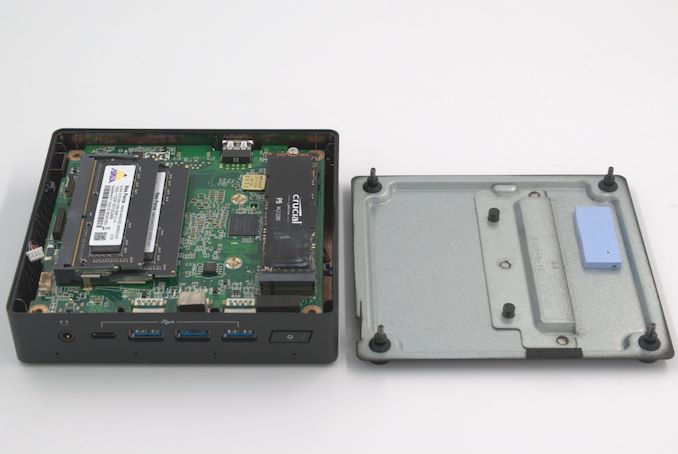
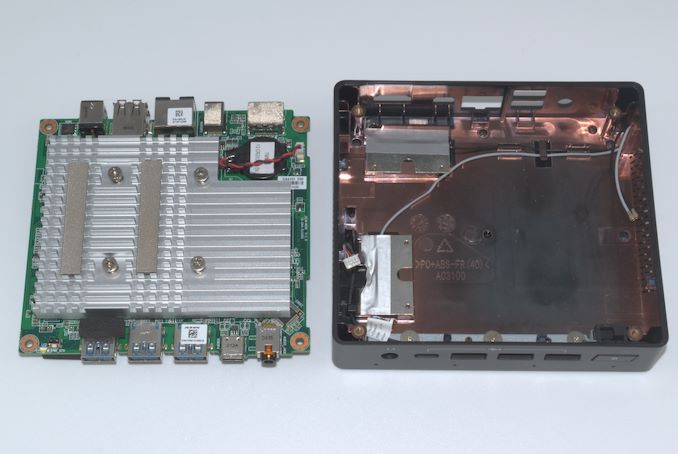
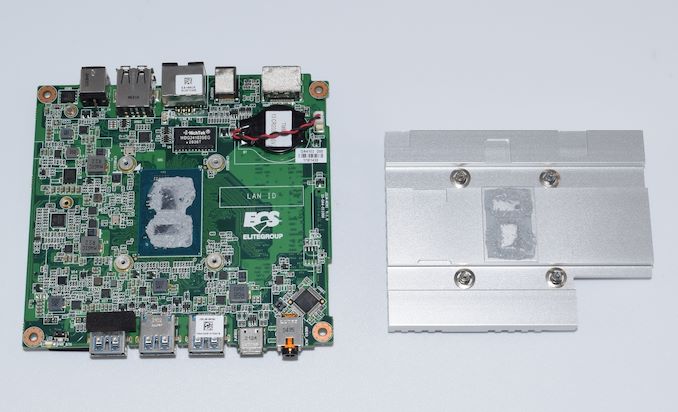
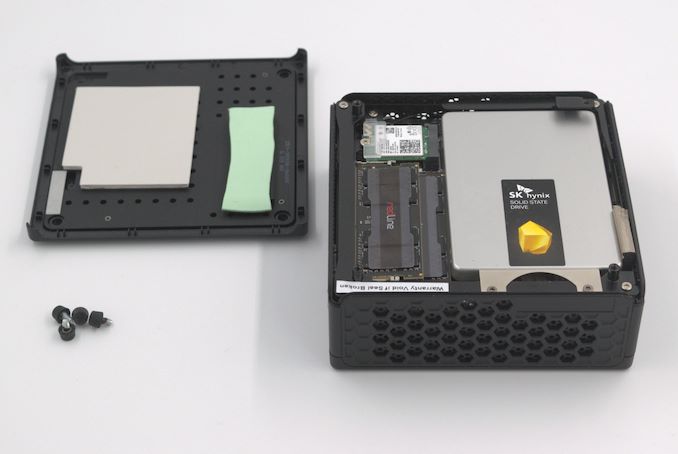
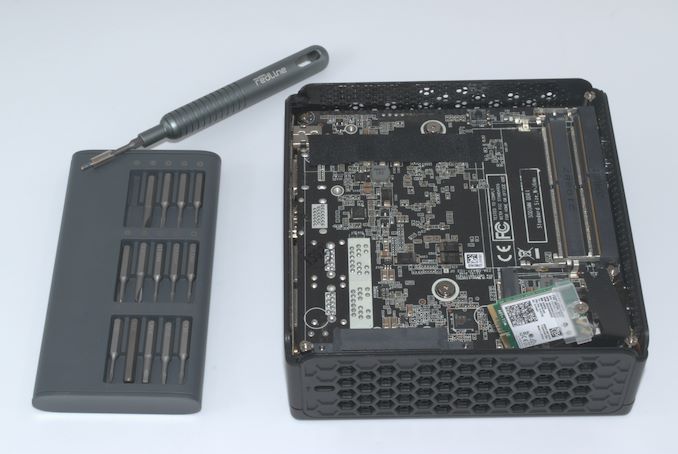
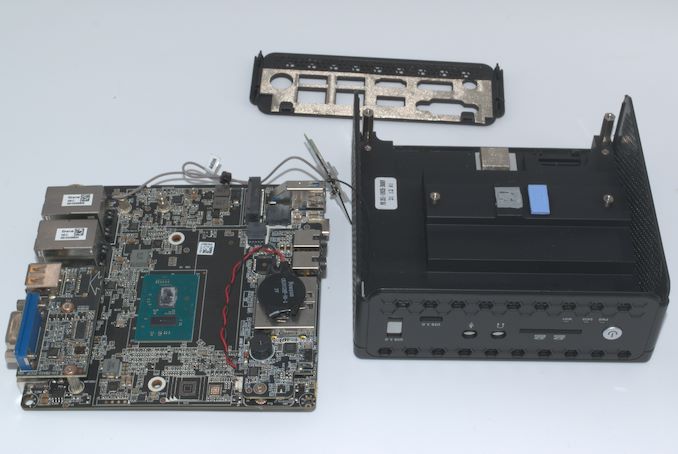










52 Comments
View All Comments
IntelUser2000 - Saturday, July 9, 2022 - link
I hope Alderlake-N gets a SoC variant of the 10nm process unlike the HP process for regular Alderlake.nandnandnand - Saturday, July 9, 2022 - link
It will be a shrink from 10nm to Intel 7 (formerly 10nm Enhanced SuperFin), and they should have different cell libraries available. I think they'd want the densest one. I'm sure whatever it becomes will be impressive compared to Jasper Lake.More importantly, I hope we see a lot of the 8-cores.
Thala - Tuesday, July 12, 2022 - link
Of course 8cx devices are more premium. But I was not referring to price, but to what it is technically possible within a 7W power envelope if you include devices, which does not contain Intel CPUs. It just shows that Intel CPUs are incredibly power inefficient independent of price. This includes Lakefield, Jasperlake or whatever CPU Intel designed for the sub 9W TDP market.IntelUser2000 - Saturday, July 9, 2022 - link
In MT yes. It's still quite a bit faster in ST.In ST if not under emulation both CPUs are roughly comparable.
mode_13h - Sunday, July 10, 2022 - link
Ganesh & Ryan:Above, we were talking about how Jasper Lake compares with Skylake and ARM A76 cores. It would be fantastic to have some hard data on this. Why not run SPEC bench on these mini PCs? It can't be any less weird than running it on a iPhone, right?
mode_13h - Sunday, July 10, 2022 - link
Oops, meant to say: "... can't be any weirder than running it on an iPhone"PeachNCream - Sunday, July 10, 2022 - link
A few typos here and there but a good review of hardware that might, for once, realistically land on someone's desk these days. Pity about the Liva's cooling situation. I wonder if chopping open a fair amount of the case top and replacing it with a fan grille or an epoxy-attached bit of non-metallic screen would be sufficient to mitigate the cooling problems while still retaining the bulk of the case itself. Too bad ECS didn't do potential buyers any justice with this design since the cost is otherwise okay.abufrejoval - Monday, July 11, 2022 - link
I can’t help but wonder if Anandtech feels a certain affinity to near-death technology these days…Jasper Lake is unfortunately dead. Whatever is being sold, was manufactured long ago and these systems are the typical leftover stock that Intel is pushing out the back door, as it reduces internal stockpiles to cover long-term warranties: nearly rock bottom, in other words.
I’ve been using Atoms since the J1900 on ASRock Mini-ITX boards, that were 100% passive, simply because they were 100% passive and thus zero noise: a somewhat novel experience ever since I switched from an Apple ][ [clone] to an IBM-AT [clone], which unfortunately started the trend on noisily moving parts.
And one constant has been, that Atoms have always supported way more RAM than advertised. It was 16GB or DDR3 on the DDR3 Atoms, 32GB for the J5005 devices I’ve been running as a oVirt(RHEV) cluster for a couple of years now.
A couple of weeks ago a Jasper Lake or Atlas Canyon NUC11 (NUC11ATKPE) popped up on my radar and since I’d been on a constant lookout for them, I immediately grabbed one, only to see that it might have been both, the first and last gasp of a phantom device: it’s been unavailable since, just as it was for it’s entire official life-time before.
And after putting it through its paces that is quite sad, because it really is a rather strappy and solid little machine, especially at a 2x Raspberry PI4 price point. It performs near identical to a Sandy Bridge i7-2600 and beats the Pi into a pulp with only a tiny helping of extra Watts: 10 vs 28nm does make a difference!
And again, just as you noticed, Jasper Lake will run just fine with far more RAM than Intel wants you to know. That is a constant with every NUC I’ve owned, i7 based NUC8/10/11 all run with 64GB just fine, even if only the Tiger Lake, from which I borrowed the dual 32GB DDR4-3200 SO-DIMMs for the Jasper Lake evaluation, did so officially.
But where my Tiger Lake will squeeze 40GB/s from that RAM, Jasper Lake will only get 25GB/s: quite a bit better than earlier Atoms, which rarely reached 10GB/s no matter what you gave them, dual-channel or not. The biggest benefit is for the iGPU, which probably won’t run Quake well enough, but does fairly well on a 4k desktop at 60Hz: the Chrome 3D Globe View render never ceases to amaze me in terms of what level of 3D interactivity is possible if the code isn’t Microsoft’s Flight Simulator. I haven't really checked, but I'd feel confident to say that it's iGPU performance is similar to the NUC10's Comet Lake UHD, which only has 24EUs but runs at roughly twice the speed. I can't go near the Tiger Lake, but none are meant for gaming.
The NUC has a fan. It’s practically noiseless and even a Prime95/FurMark combo won’t turn it into a howler, but it’s something that can clog and fail eventually. I’d have preferred another fully passive Mini-ITX from ASRock, but that was not to be. Rumor has it, OEMs quite simply refused to take Jasper Lake Atoms from Intel, even at typical contra-revenue bundle deals (effectively for free). Evidently they were stock poison, but I'd love to hear from anyone who knows more.
The Intel NUC is quite extraordinary in that it sports a front USB2 pin-grid connector covered by a rubber cap, that hints a very large signage customer OEM deal as the sole reason for its existence.
It certainly should have been given a 2.5Gbit/s Ethernet port (likely $1 extra cost), but then 1GB Ethernet simply should no longer be sold anywhere today. It also lacks SATA support, which is a bit of a bummer for someone like me, who still has quite a few SATA SSDs on hand, but a very logical choice otherwise.
But note that only two PCIe lanes are available for NVMe use, at least they are 3.0 this time, where all earlier Atoms topped out with 2.0 speeds on PCIe. The two rear USB3 ports are supposed to support 10Gbit/s, not quite Thunderbolt but please consider the TDP levels available.
The NUC chassis otherwise is extremely impressive for this price range, it feels extremely solid and built to last the 10 years perhaps expected from a digital signage device.
It seems a rather competent micro-server device and I'd thoroughly recommend it, if it was a live product. Too bad it’s dead, all you see is left-overs and there is no successor in sight.
nandnandnand - Tuesday, July 12, 2022 - link
Jasper Lake stock is being pushed out... at prices that you may actually want to buy it at. Actually, the older Gemini Lake Refresh is still being sold, in sub-$100 N4020 laptops for example.The RAM thing is weird. I recall some of the ARK pages lying about the amount of RAM supported on certain Atom models. Like saying 8 GB maximum instead of 32 GB.
The rumor mill has pointed to Alder Lake-N being the upcoming successor to Jasper Lake, with the headline change being a doubling to 8 cores. Presumably, dual-core would be gone for good and the cheapest models would become quad-cores.
There's also the embedded/enterprise-focused Elkhart Lake counterpart to Jasper Lake.
mode_13h - Wednesday, July 13, 2022 - link
BTW, Elkhart Lake supports in-band ECC, which means it doesn't limit the customer in their selection of RAM. However, it does come at a slight cost in performance and memory capacity.Too bad all the Elkhart Lake boards I see are rather pricey.
Getting back to ECC, you'd have to move to Atom C-series or P-series to get a SoC with these cores and full ECC support. See links in my post, above.